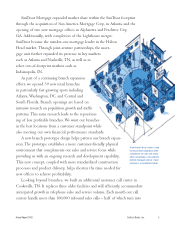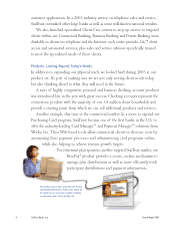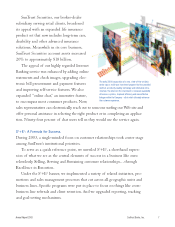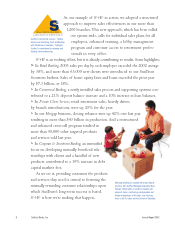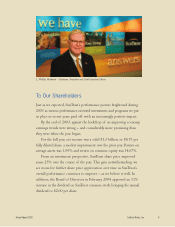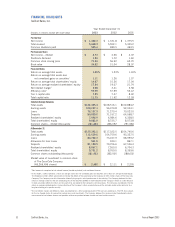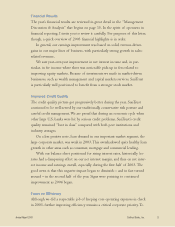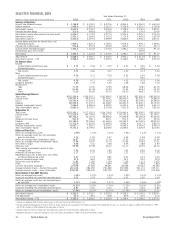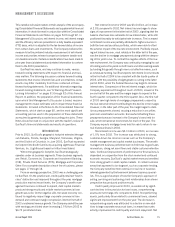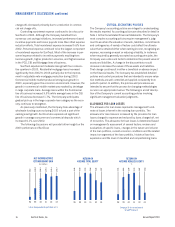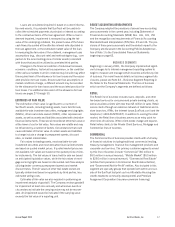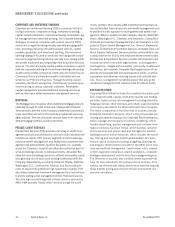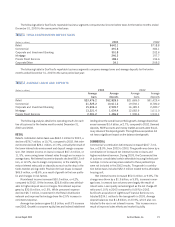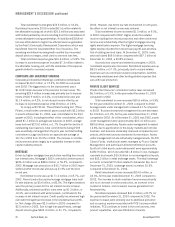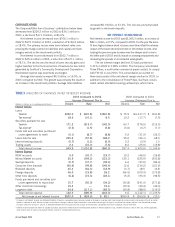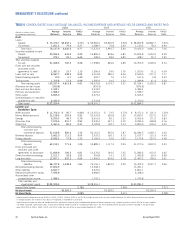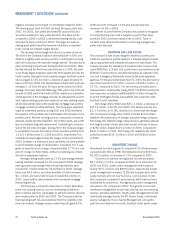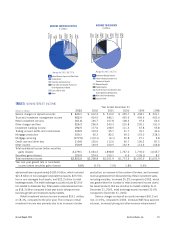SunTrust 2003 Annual Report Download - page 17
Download and view the complete annual report
Please find page 17 of the 2003 SunTrust annual report below. You can navigate through the pages in the report by either clicking on the pages listed below, or by using the keyword search tool below to find specific information within the annual report.
Annual Report 2003 SunTrust Banks, Inc. 15
This narrative will assist readers in their analysis of the accompany-
ing Consolidated Financial Statements and supplemental financial
information. It should be read in conjunction with the Consolidated
Financial Statements and Notes on pages 54 through 92. In
Management’s Discussion, net interest income, net interest margin
and the efficiency ratio are presented on a fully taxable-equivalent
(FTE) basis, which is adjusted for the tax-favored status of income
from certain loans and investments. The Company believes this
measure to be the preferred industry measurement of net interest
income and provides relevant comparison between taxable and
non-taxable amounts. Certain reclassifications have been made to
prior year financial statements and related information to conform
them to the 2003 presentation.
SunTrust has made, and may continue to make, various
forward-looking statements with respect to financial and busi-
ness matters. The following discussion contains forward-looking
statements that involve inherent risks and uncertainties. Actual
results may differ materially from those contained in these
forward-looking statements. For additional information regarding
forward-looking statements, see “A Warning About Forward-
Looking Information” on pages 51 through 52 of this Annual
Report. In addition, the preparation of the financial statements,
upon which this Management’s Discussion is based, requires
management to make estimates which impact these financial
statements. Included in the Notes to the Consolidated Financial
Statements, which start on page 60, are the most significant
accounting policies used in the preparation of these statements
as required by generally accepted accounting principles. These
Notes should be read in conjunction with the reader’s review of
SunTrust’s financial statements and results of operations.
INTRODUCTION
Prior to 2003, SunTrust’s geographic footprint extended through-
out Alabama, Florida, Georgia, Maryland, Tennessee, Virginia,
and the District of Columbia. In June 2003, SunTrust expanded
its footprint into South Carolina by acquiring Lighthouse Financial
Services, Inc. (Lighthouse) based on Hilton Head Island.
Within the geographic footprint, SunTrust strategically
operates under six business segments. These business segments
are: Retail, Commercial, Corporate and Investment Banking
(CIB), Private Client Services (PCS), Mortgage and Corporate/
Other. For a complete description of each line of business, please
see pages 17 through 18.
From an earnings perspective, 2003 was a challenging year
for SunTrust. On the positive side, credit quality retained “best in
class” distinction and improved throughout the year, mortgage
production reached record levels, the Company’s wealth man-
agement business continued to expand, debt capital markets
produced strong results and middle market commercial loan
growth was solid. On the negative side, the weak economy con-
tinued to negatively impact large corporate commercial loan
demand and continued margin compression into the first half of
2003 constrained revenue growth. The Company ended the year
with earnings per diluted share increasing 1.5% from 2002 to
$4.73 per diluted share.
Net interest income for 2003 was $3.4 billion, an increase
of 2.5% compared to 2002. Net interest income began to show
signs of improvement in the latter half of 2003, signaling that the
balance sheet was less vulnerable to low interest rates, while still
positioned favorably for anticipated rate increases. The increased
net interest income was partially attributed to higher volumes in
both the loan and securities portfolios, which were able to offset
the adverse impact of the low rate environment. Positively impact-
ing net interest income, most notably in the latter half of the year,
was the decline in mortgage prepayments along with the steepen-
ing of the yield curve. To combat the negative effects of the low
rate environment, the Company was continually managing its cost
of funding versus the yields on both loans and other earning assets
by funding this growth through more cost effective means, such
as wholesale funding. SunTrust expects net interest income results
in the first half of 2004 to be consistent with the fourth quarter of
2003, with the possibility of slight growth occurring in the latter
part of 2004, when the Federal Reserve may begin to increase
interest rates. Compression of the net interest margin, which the
Company experienced throughout much of 2003, slowed in the
second half of the year and the margin began to expand in the
fourth quarter compared to the third quarter. Also, the first half
of 2003 saw high levels of mortgage prepayments caused by
the low rate environment contributing to the decline in the margin.
However, in the latter part of the year, the margin began to stabi-
lize as prepayments slowed, causing a reduction in securities
premium amortization amounts. Somewhat offsetting these
prepayments was an increase in the Company’s loans held for
sale, which remained at record levels for much of the year. The
Company expects mortgage loans held for sale to return to nor-
mal historical levels in 2004.
Noninterest income was $2.3 billion in 2003, an increase
of 1.5% from 2002. The increase was attributed to strong,
customer-driven fee income in areas such as the Company’s
wealth management and capital market businesses. The wealth
management business performed well in 2003 due to good sales
momentum, strong net asset flows and stable customer retention
rates. Continued improvement of performance for this business is
dependent on cooperation from the stock market and continued
economic recovery. SunTrust’s capital market revenues benefited
from strong growth in debt capital markets. In certain business
areas that appeared to be stagnant, such as corporate lending,
the Company benefited from extensive cross line of business
referrals generated by the teamwork between business special-
ists. This is a good example of how the Company’s approach of
selling, servicing and sustaining client relationships from a team
perspective has produced positive results.
Credit quality improved in 2003, as evidenced by signifi-
cant declines in the provision for loan losses, nonperforming
assets and net charge-offs compared to 2002. Nonperforming
assets, particularly those related to commercial loans, showed
significant improvement from the prior year. The decrease in
nonperforming assets was attributed to a decline in new addi-
tions to large corporate nonaccrual loans, increased loan sales
activity, improvement in credit quality and client repayment. Net
MANAGEMENT’S DISCUSSION


